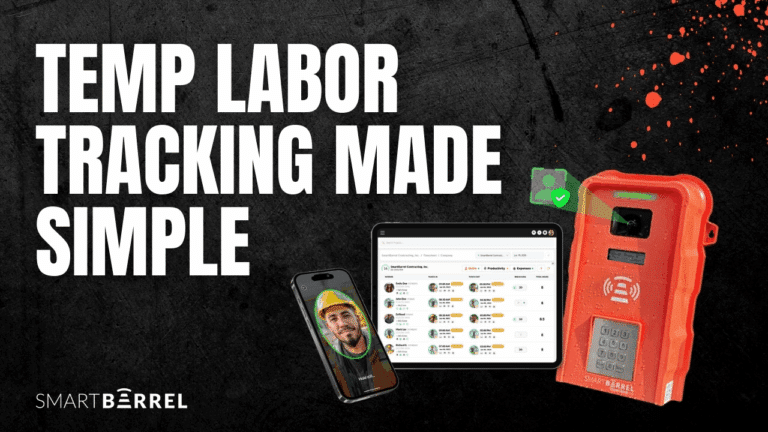Paper timesheets have been around forever. Crews rely on them to track hours, jot down when people clocked in and out, and try to keep things running. But let’s be honest, those paper logs are holding you back.
As jobs get bigger and timelines get tighter, the cracks in the system start to show. Hours get rounded up. Breaks get forgotten, workers punch in for each other, and a lot more. Suddenly, your labor costs and billing hours are way off when compared to the plans.
In construction, labor eats up a majority of your budget. Just a few padded hours here and there can tip a project from profit to loss. Add in payroll delays or missing timesheets, and the whole thing starts to spiral.
The old system you rely on isn’t just outdated. It’s costing you real money.
What Is The Meaning Of Padding Hours In Construction?
Let’s be real–we’ve all rounded up our hours once or twice. “I left at 4:52… let’s call it 5.” But in construction, those “harmless” little white lies add up fast.
Padding hours is when workers log more time than they actually worked. It’s not always malicious, sometimes it’s just:
- Rounding up (“7 hours and 50 minutes? Let’s make it 8”)
- Forgetting to deduct lunch breaks
- “Buddy punching” for coworkers running late
If your crew pads just 40 minutes a day, that adds up to about 4 hours of lost time a week. At $45/hour, that’s $180 per week — or roughly $4,500 over a 6-month project timeline.
Syber Concrete had a similar problem. They wanted to ensure that no part of their budget goes towards employees who were not on-site and working. But paper timesheets could not fight against all the time discrepancies and payroll chaos. All that became a thing of the past when they shifted to AI-powered biometric facial verification for manpower tracking.
You might be wondering if time padding is a serious issue at all. It’s just 15 minutes here or there. How harmful could it be? Well, take a look at the breakdown below to understand the real impact of time padding.
Crew Size | Daily Padding | Weekly Cost | Annual Cost |
10 | 30 mins/day | $1,125 | $58,500 |
25 | 15 mins/day | $1,406 | $73,125 |
50 | 20 mins/day | $3,750 | $195,000 |
The numbers are based on the $45/hour average wage by the U.S. Bureau of Labor Statistics
On average, 26% of the construction industry still uses paper timesheets, and around 50% believe that they can do a lot better when it comes to tracking time and making informed decisions based on real-time data. Our experience says the same. Harper Electric, for example, saw a 70% reduction in its payroll discrepancies once it switched to digital systems.
Get Control of Your Time Tracking
Why Paper Timesheets Enable Padding
Paper timesheets are an outdated tool for construction time tracking that makes it easy to pad hours. Here’s exactly how they do it:
1. Logging From Memory
When you fill out your hours at the end of the day, or worse, at the end of the week, it’s a lot of guesswork.
There’s no real-time log and no verified records—just a rough estimate. You can only hope that your foreman or your crew remembered it right. Multiply that uncertainty across the whole crew, and your hours drift fast.
2. Too Many Handoffs
While time theft is a major issue, there are several times when things are not malicious in intent behind it. The age-old human error can come into play and create issues. Every handoff introduces errors:
- Worker → signs in on a paper timesheet
- Foreman → reviews timesheets manually, makes corrections, chases down workers
- Office admin → enters handwritten timesheet hours into the payroll system
Notice how many potential points of error are in this process? At each step:
- Numbers get rounded up
- Mistakes compound
What you end up with is additional padded hours per jobsite. All of which adds up to significant financial losses for you.
3. Delayed Approvals
Paper floats around. Sometimes it sits in trucks. Sometimes it’s forgotten on a desk. By the time supervisors review it, they cannot verify anything.
So they automatically approve it anyway. Just to keep payroll moving.
This rubber-stamping approach can lead to several errors and inflated hours. Harper Electric, for example, achieved a 20% reduction in payroll errors simply by adopting digital solutions.
4. No Standard Format
Some crews write “7.5 hrs,” others “7:30,” or even “seven and a half.” Some use a pen, and others a pencil.
It sounds small, but these differences slow things down. When admins have the additional task of interpreting handwriting or formats, things slip through the cracks. As a general rule of thumb, you should remember that the more processing required, the more chances there are of padding hours.
The Hidden Cost Of Padding Hours
Padding hours doesn’t just mess with your payroll. It affects everything on the job. From legal headaches to lost time on-site, the damage runs deeper than you think.
1. Legal Penalties
Missing pay deadlines or overpaying based on bad timesheets can land you in hot water if you are not compliant with local labor laws. Fines, audits, lawsuits, all add up fast, and the cost can be more than the money.
If your reputation takes a hit, then it’ll be hard to attract clients and keep skilled crews.
2. Unhappy Crew
When pay isn’t accurate or on time, your crew notices. A frustrated crew leads to low morale, and people may stop showing up or start looking elsewhere. Finding good replacements can cost both time and money, and that’s something you might not always be ready to deal with.
3. More Admin Headaches
Admin work is among the largest overhead costs in a construction project, and payroll issues can increase that. Payroll teams can spend hours chasing down missing info, correcting errors, and smoothing out disputes. That slows down pay runs and drags your whole back office down.
4. Delays That Stack Up
We already covered how productivity takes a hit when workers aren’t paid correctly or on time. Your crew takes longer breaks, drags out tasks, and the whole schedule starts to slide. What should’ve been done Wednesday rolls into next week, and the whole situation cascades.
5. Cost Overruns
When payroll’s late, everything backs up. Crews slow down, you fall behind schedule, and now you’re paying overtime, bringing in last-minute help, and rushing material deliveries just to stay afloat. Those costs pile up fast, and your margins take the hit.
Get Control of Your Time Tracking
How Digital Time Tracking Prevents Padding Hours
The construction industry’s shift to digital time tracking isn’t just about modernization. It’s about closing the loopholes that paper timesheets inherently create. Unlike manual systems that rely on memory and goodwill, solutions like SmartBarrel use layered verification to make padding hours impossible.
Here’s how the technology works to protect your profits:
Automated Time Logging
Digital systems handle time logs automatically, eliminating the need for manual entry and reducing human error. SmartBarrel captures each punch in real time as soon as a worker clocks in. Breaks, overtime, and shift rules can be configured by project, ensuring time is tracked according to your specific requirements.
Real-Time Data Access
Digital systems give supervisors and payroll teams immediate access to up-to-date timesheet data. This means no surprises at the end of the week/month when you sit down to consolidate your data and address discrepancies. Now you can work towards removing any wrong entries or other errors as soon as they are flagged.
Geo-Fencing & Mobile Access
Geo-fencing ensures workers can only clock in while on-site, eliminating off-site clock-ins. Workers can’t log hours if they aren’t physically on the jobsite, which provides accurate data and eliminates opportunities for padding hours.
Facial Verification
Buddy punching is no more when facial verification guards your clock-ins. Biometric systems that require AI-powered photo verification for every punch can help you ensure that phantom workers are something your team never deals with.
Integrated Payroll Sync
With digital time tracking systems like SmartBarrel, timesheets sync automatically with payroll and ERP systems. This reduces the chance of mistakes that could delay payroll. All your data will flow directly from the field to the office without the need for manual entry or approvals. This speeds up your entire process and ensures 100% accuracy of your data.
Best Practices To Prevent Padding Hours In Construction
Now that you understand the impact of padding time, here are some best practices to help eliminate it:
1. Go Digital
Transitioning from paper timesheets to a digital time tracking solution is the first step in eliminating time theft and payroll delays. By automating time entry, you reduce errors and improve accountability. Using biometric systems and geo-fencing technology ensures that workers are only clocking in when they’re on-site and performing the work assigned to them.
2. Use Integrated Platforms
Ensure that your time tracking system integrates seamlessly with payroll and project management systems. This allows time data to flow automatically, reducing the chances of mistakes and discrepancies. When all systems are connected, approvals happen faster, and payroll is processed more efficiently.
3. Ensure Real-Time Data Access
Having access to real-time data ensures that any discrepancies are caught as soon as they happen. This reduces lag time in payroll processing and avoids delays caused by missing or incorrect timesheets. Real-time visibility helps keep your project and payroll on track.
4. Train Employees
The most sophisticated systems are only as good as the workers using them. Make sure your team understands how to log their hours accurately, why it’s important, and the impact of inaccurate data. Ongoing training helps reduce errors and ensures that your crew follows the correct time tracking process.
5. Automate Alerts and Notifications
Automated alerts for missing punches, overdue approvals, or incomplete timesheets ensure nothing falls through the cracks. By reducing manual oversight, you can streamline the payroll process and ensure that all time worked is recorded and paid for accurately.
6. Conduct Regular Audits
Auditing timesheet data regularly helps prevent discrepancies and reduces the chance of errors before payroll is processed. Catching mistakes early on saves time and resources in the long run and ensures that no payroll delay happens due to inaccurate data.
7. Use Tools Built for Construction
Ensure that the digital solution you choose is specifically designed for the construction industry. The system should support biometric verification, offline functionality, and the ability to work across job sites without needing an internet connection.
Get Control of Your Time Tracking
The Benefits of Replacing Paper Timesheets With Digital Time Tracking
Just like how finances are not the only aspect affected by padding hours, the benefits can be multifaceted. Digital time tracking provides multiple advantages to how your crew runs a jobsite. Here’s how:
Feature | Paper Timesheets | Digital Time Tracking |
Data Entry | Manual entry with a higher chance of error | Automated logs that eliminate errors and save processing time |
Data Access | Needs to be collected, reviewed, and processed manually | Real-time access to timesheet data that speeds up payroll processing |
Record Consistency | Inconsistent format that takes time to analyze and process | Standardized records for better processing |
Approval Process | Requires manual signatures and approvals | Streamlined digital approval process, which allows instant approvals |
Payroll Efficiency | Slow processing due to manual checks | Faster processing due to automated systems and real-time data |
Compliance | Risk of non-compliance with labor laws due to errors | Built-in compliance features |
Say Goodbye To Paper Timesheets And Payroll Delays With SmartBarrel
Say Goodbye To Paper Timesheets And Payroll Delays With SmartBarrel
There’s no doubt that paper timesheets are slowing you down. SmartBarrel helps you move faster, track cleaner, and bill smarter. Here’s what it does:
- Fewer Errors, Fewer Delays: Automating time tracking means no more data entry mistakes. Your team’s hours are logged in real time, accurately, every time.
- Stronger Team Morale: On-time pay is crucial for workforce satisfaction. When your workers are paid on time, they’re more motivated and loyal.
- Less Admin Work: Integrated time tracking systems cut down manual work, speed up payroll, and free up your back office to focus on high-impact tasks.
- Tighter Project Timelines: Real-time data and automatic approvals keep payroll moving and your schedule on track.
Ready to stop time theft at work and get back in control?
SmartBarrel makes it easy. No more guesswork, no more delays, no more wasted dollars. From real-time time tracking to seamless payroll sync, you get full visibility into your crew’s billing hours without chasing paper.
Register for a demo today and see how simple it is to bring accuracy, speed, and accountability back to your jobsite.




